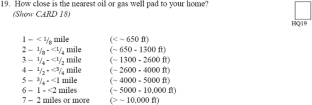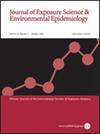Accuracy of self-reported distance to nearest unconventional oil and gas well in Pennsylvania, Ohio, and West Virginia residents and implications for exposure assessment
IF 4.1
3区 医学
Q2 ENVIRONMENTAL SCIENCES
Journal of Exposure Science and Environmental Epidemiology
Pub Date : 2024-03-06
DOI:10.1038/s41370-023-00637-8
引用次数: 0
Abstract
Self-reported distances to industrial sources have been used in epidemiology as proxies for exposure to environmental hazards and indicators of awareness and perception of sources. Unconventional oil and gas development (UOG) emits pollutants and has been associated with adverse health outcomes. We compared self-reported distance to the nearest UOG well to the geographic information system-calculated distance for 303 Pennsylvania, Ohio, and West Virginia residents using Cohen’s Weighted Kappa. Agreement was low (Kappa = 0.18), and self-reports by Ohioans (39% accuracy) were more accurate than West Virginians (22%) or Pennsylvanians (13%, both p < 0.05). Of the demographic characteristics studied, only educational attainment was related to reporting accuracy; residents with 12–16 years of education were more accurate (31.3% of group) than those with <12 or >16 years (both 16.7%). Understanding differences between objective and subjective measures of UOG proximity could inform studies of perceived exposures or risks and may also be relevant to adverse health effects. We compared objective and self-reported measures of distance to the nearest UOG well for 303 Appalachian Basin residents. We found that residents’ self-reported distance to the nearest UOG well had limited agreement with the true calculated distance category. Our results can be used to inform the collection and contextualize the use of self-reported data in communities exposed to UOGD. Self-reported metrics can be used in conjunction with objective assessments and can be informative regarding how potentially exposed populations perceive environmental exposures or risks and could provide insights into awareness of distance-related policies, such as setbacks.


宾夕法尼亚州、俄亥俄州和西弗吉尼亚州居民自我报告与最近非常规油气井距离的准确性及其对暴露评估的影响。
在流行病学中,自我报告的与工业污染源的距离被用作暴露于环境危害的替代物以及对污染源的认识和感知指标。非常规油气开发(UOG)会排放污染物,并与不良健康后果相关。我们使用科恩加权卡帕法比较了 303 名宾夕法尼亚州、俄亥俄州和西弗吉尼亚州居民自我报告的与最近的 UOG 油井的距离和地理信息系统计算的距离。两者的一致性较低(Kappa = 0.18),俄亥俄州人的自我报告(准确率为 39%)比西弗吉尼亚州人(准确率为 22%)或宾夕法尼亚州人(准确率为 13%,P 均为 16 岁,均为 16.7%)更准确。了解客观和主观测量UOG邻近性之间的差异,可为有关感知暴露或风险的研究提供信息,也可能与不良健康影响有关。影响:我们比较了 303 位阿巴拉契亚盆地居民客观和自我报告的与最近的铀浓缩物井的距离。我们发现,居民自我报告的与最近 UOG 井的距离与真实计算距离类别的一致性有限。我们的研究结果可用于在受铀-氧化物-酸性气体排放影响的社区收集自我报告数据,并为其使用提供参考。自我报告的指标可与客观评估结合使用,可提供有关潜在暴露人群如何看待环境暴露或风险的信息,并可提供对距离相关政策(如后退)的认识。
本文章由计算机程序翻译,如有差异,请以英文原文为准。
求助全文
约1分钟内获得全文
求助全文
来源期刊
CiteScore
8.90
自引率
6.70%
发文量
93
审稿时长
3 months
期刊介绍:
Journal of Exposure Science and Environmental Epidemiology (JESEE) aims to be the premier and authoritative source of information on advances in exposure science for professionals in a wide range of environmental and public health disciplines.
JESEE publishes original peer-reviewed research presenting significant advances in exposure science and exposure analysis, including development and application of the latest technologies for measuring exposures, and innovative computational approaches for translating novel data streams to characterize and predict exposures. The types of papers published in the research section of JESEE are original research articles, translation studies, and correspondence. Reported results should further understanding of the relationship between environmental exposure and human health, describe evaluated novel exposure science tools, or demonstrate potential of exposure science to enable decisions and actions that promote and protect human health.

 求助内容:
求助内容: 应助结果提醒方式:
应助结果提醒方式:


